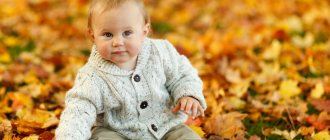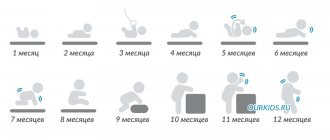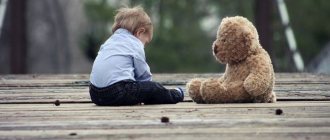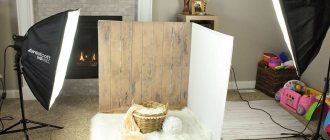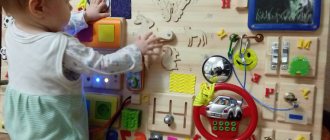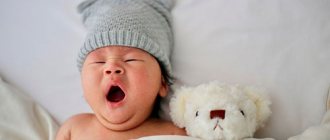The main changes that occur with a child in the first three months
- The child develops chubby cheeks and folds on the limbs, including the elbows and knees. This occurs due to the active development of subcutaneous adipose tissue.
- The child becomes capable of many new movements. At three months, he can already independently roll over from his stomach to his back and vice versa, and also stand for a long period of time, leaning on his forearms.
- The child develops his own daily routine. He begins to want to sleep, eat and play only at certain intervals. This makes planning for baby care much easier at three months.
- The child begins to more actively explore the world around him. He will begin to taste many objects.
Features of physical development
By three months, babies rapidly gain weight and height. Over another thirty-day period, the baby grows by 2.5-4 centimeters. And body weight increases by another 600 - 1000 grams.
There are average standards for how much a child should weigh at 3 months. For boys, weight can range from 5.7 to 7.3 kg, for girls - from 5.2 to 6.7 kg.
Growth should be within:
- 59.4 – 63.6 centimeters for boys;
- 57.6 – 62 centimeters for girls.
If your baby's readings deviate from the norm, don't panic.
Activity, good appetite, and no problems with bowel movements indicate that everything is fine with the baby. All children have individual growth and development rates.
Vision and hearing
By this age, strabismus disappears. The child perfectly focuses his gaze on objects that interest him. He examines the surrounding objects with interest. Kids love to be carried in a column, showing the situation.
At three months, the baby enjoys listening to music. It is able to determine the source of the sound. The baby learns to relate object and sound. He reacts to his mother’s voice with a smile and turns his head in her direction.
Physical activity
The baby's movements are meaningful and less chaotic. The fists are partially open. The baby may not hold the rattle for long. He actively reaches out to toys hanging on the bed and tries to grab them.
Physiological hypertonicity passes. Legs and arms are relaxed. The baby often pulls them out and spreads them apart. Lying on his back, he turns on his side, tries to roll over onto his stomach. All movements are aimed at more active knowledge of the world around.
If you lay the baby on his tummy, he holds his head. Closer to four months, he tries to sit up, leaning on his forearms.
A big leap occurs in a child's development at 3 months. Innate reflexes fade away, conditioned ones become more pronounced.
If your baby still has the following reflex reactions, you should consult a neurologist:
- when stroking the corner of the mouth, the baby turns its head in the direction of the touch;
- when touching the upper lip, the child pulls out the lips with a tube;
- When you press your fingers on the center of your palm, he pulls his head forward and opens his mouth.
It is considered normal if, when raising the baby’s legs in a horizontal position, he throws up his arms.
Changes in height and weight
Physical changes in a child are conditional indicators of the rate of development of his body. It is changes in height and weight that pediatricians pay the most attention to when visiting them in the first years of life. It is worth noting that there are no exact height and weight measurements for all children aged three months. Due to the characteristics of different organisms, heredity and growth conditions, changes in a child's height and weight may fluctuate. However, a rough guideline for a three-month-old baby could be a weight of 3-6 kilograms and a height of 54-64 centimeters.
Developmental indicators of a 3-month-old baby
Three months have passed since the birth of the child. Your life is now full of worries, but new colors have appeared in it! The baby is growing at a fast pace, and every day brings new surprises. You see that he is developing more and more new skills. These developmental indicators indicate how well a child's development and growth are appropriate for his or her age.
Let's consider what indicators a child reaches at 3 months and how developmental delays can be identified.
List of development indicators for a three-month-old baby
| Achieved development indicators | Emerging development indicators |
| The child raises his head 45º while lying on his stomach | The child can raise his head 90º |
| The child straightens his legs when his parents put him in an upright position | The child can transfer his body weight to his legs when the parents place him in an upright position |
| Child brings hands to mouth | The child can join hands |
| The child grabs objects that are within his reach | The child may try to reach objects that are out of his reach |
| The child shakes objects in his hands | The child can slap the object on the surface and play with it |
| The child follows moving objects in his field of vision | The child can turn his head to follow objects |
| The child behaves quietly and reservedly in the presence of strangers | The child experiences anxiety in the presence of strangers |
| The baby's back muscles are strong enough to lie on his stomach | The child can sit with parental support |
| The child can imitate some actions | The child can imitate more actions |
| Baby can support body weight in arms when lying on stomach | Baby can roll over in one direction |
Developmental indicators of a three-month-old baby
By three months of age, your baby is making progress in three major areas of development: cognitive, social, and emotional. In each area, he achieves a number of indicators.
Indicators of cognitive development
At the age of three months, the baby develops intelligence, cognitive abilities and thinking in general.
1. The child recognizes familiar faces from a distance. Whereas before you had to get close to your baby to get his attention, now your baby can recognize you when you walk into the room and make sounds.
2. The child looks for the source of the sound by turning his head. When a child hears something interesting, scary or familiar, he turns his head in that direction. This indicates that the child's brain is able to detect the source of sound through hearing.
3. The child responds when you interact with him. Talk to your child and he will most likely make a sound in response. Children as young as three months already understand that when they are told something, they need to respond.
4. The child can imitate certain sounds. He tries to repeat his parents' words and other sounds he hears around him. His imitation may be just babble, but over time it will become much better.
5. The child can imitate certain actions. He tries to reproduce the actions that he notices in his parents. Such imitation requires significant mental effort and is an important achievement in the child's development.
Indicators of physical development
This category includes the development of motor skills as well as growth and physical abilities.
6. The child holds his head. At three months of age, he has better control of his neck muscles, which helps him hold his head up while feeding or when you hold him.
7. The child raises his head 45º while lying on his stomach. As his neck muscles become more developed, he can lift his head. This greatly expands his field of vision. Lying on his stomach, the baby can see toys and other objects in the room.
8. The child can see objects in a range of 180º. Play a simple game with your child: show him a toy and slowly move it in a circle. You will notice how the child follows the toy by moving his head. You can also move the toy left and right: the child will follow it. This indicates that the child has developed vision and object tracking skills.
9. The child straightens his legs when his parents put him in an upright position. When you place him on the floor while supporting him, he straightens his legs as if he is trying to stand on them. At three months of age, he cannot yet support his own weight on his feet, but the ability to assume the posture necessary for standing has already been developed.
10. The child can support his body weight on his forearms, lifting himself up on his stomach. He can even push off on his hands, like a push-up. This ability lays the foundation for crawling, the first mode of movement in a child’s life.
11. The child grabs objects, clenches and unclenches his fist. The developed ability to hold objects in the hand and dexterity of the fingers allow him to grab toys and other objects. The child also runs his hand over objects, such as rattles hanging from the stroller. At this age, the child also develops hand-eye coordination, which is an important motor skill.
12. The child brings his hand to his mouth. At the age of three months, the baby can bring his hands to his mouth and suck his fingers. At this age, the child begins to use his hands, which by this age become more relaxed than before.
13. The child kicks while lying on his back. This is how he first studies the movements of the legs and trains their muscles.
14. The child sleeps an hour less than before. In the first two months of their lives, babies sleep approximately 16 hours a day. At three months of age, sleep time decreases to 15 hours.
Indicators of social and emotional development
At three months of age, the baby is also developing his social skills and emotions.
15. The child smiles at familiar people. Already in the seventh week of life, the child can smile when he hears the voice of his parents. A smile is a way of saying, “Hi, how are you?” people he knows. A child's smile is a social action because it is his way of trying to get a response. Smiling can also be accompanied by body movements. For example, he may reach out to his parents or make sudden movements with his legs out of excitement.
16. The child begins to laugh. At three months of age, you can hear your baby laughing loudly. Laughter first appears between the ages of 3 and 4 months.
17. The child loves to play with his parents. And this is not surprising. The child enjoys both playing with toys and simple games based on hand movements.
18. The child treats strangers calmly. Although he always greets his parents and acquaintances with a joyful smile, one should not expect the same joy towards strangers. Seeing a stranger, a child may fleetingly smile in response to his smile or generally behave warily.
19. The child shows interest in brothers and sisters. If a child has siblings, at the age of three months the child begins to recognize them. If they approach the child and talk to him, he answers them with a smile and a coo. The child also shows interest in other children.
Just imagine how many new skills a child acquires in the third month of life. This is simply wonderful! But what if your baby doesn't show the signs described above? This may indicate developmental delays.
What might be a cause for concern?
Be on the lookout for the following symptoms that your three-month-old baby may experience:
1. The child does not smile or respond to familiar faces. If a child does not show any emotion, even if one of the parents approaches him, as if he does not recognize them, this may indicate a developmental delay.
2. The child does not make any sounds. If you don't hear your baby cooing, babbling, or laughing, this is a serious symptom that may indicate developmental delays. The child must be shown to the pediatrician as soon as possible.
3. The baby's head swings back and forth. By three months, babies can usually hold their head up well. If your baby can't hold his head upright when lying on his tummy or when you lift him up, this may be a sign of developmental delay.
4. The child cannot hold objects in his hands. A developmental delay may be indicated by the fact that the child cannot grasp objects, his grip is too loose (the object falls out of his hands), or the child does not try to hold the object that you put in his hand.
5. The child can follow objects or look for the source of a sound. By three months, the baby can usually track objects that move in a circle or arc. He also reacts to sounds and voices around him. Failure to do this indicates developmental delay.
6. The child does not pay attention to new faces or, on the contrary, is very frightened of new people next to him.
Parents are advised to keep a checklist and monitor all developmental indicators of the child to prevent any developmental problems. You can also help your child's development by following a few simple tips.
Tips on how to help a three-month-old baby develop
To ensure your child develops at the right pace, follow these steps:
1. Place your baby on his stomach often and for long periods of time. This strengthens the child's various muscle groups - from the arms to the abdomen. Strong muscles will help your baby begin to crawl. Play games that force your child to look around - this will help him strengthen his neck muscles.
2. Interact with your child. Talk to him regularly and interact in other ways. This will develop his ability to listen and respond. His social skills will also develop.
3. Describe your actions out loud. For example, if you are reading a picture book to your child, say out loud, “This is a book. I’ll read now.” The child may not understand you, but the next time you say this phrase, he will already associate it with your action. Your words will help your child understand the daily routine.
4. Play games that involve your child tracking objects. Tie a rope to a toy car. Stretch the car along the room for your child to watch. Place a toy train in front of your child and let your child watch the train travel in circles on the tracks. This way the baby will develop the skill of tracking objects, which is very important at three months of age.
5. Use sounds to get your child's attention. Another important skill at this age is listening. At the age of three months, the child turns his head towards the source of the sound. So play games with your baby using rattle sounds or your voice. The sounds will attract the child's attention.
Providing your child with the activities he needs and keeping an eye out for warning signs will help ensure your child's healthy development. Remember that each child is individual, and each one needs their own time to achieve this or that goal. The best way to support development is to have your child checked regularly by your pediatrician. Proper care will help your child develop and grow healthy.
Related links:
- Important developmental indicators in the first year of life
- Developmental indicators of a 2-month-old baby
- Developmental indicators of a 1-month-old baby
- How to understand your baby's body language: tips for parents
- More articles on child development
Factors influencing changes in height and weight
As mentioned earlier, one cannot expect exact results in the development of a child’s height and weight in the first three months, since this is influenced by a greater number of factors. First of all, genetic predisposition. Some children, due to hereditary factors received from their parents, physically develop much faster than their peers, while others, on the contrary, are somewhat behind. These are not signs of diseases, just features of the development of different organisms. The type of diet also influences the child’s physical development.
When breastfeeding, the baby usually gains weight faster, and the difference with feeding with dry formula can reach from half a kilogram to two.
It is worth noting that it is almost impossible to overfeed a baby while breastfeeding. However, there are frequent cases of child malnutrition when the mother violates the feeding technique, namely, not allowing the child to spend enough time at the breast or changing breasts too often during feeding.
Age dynamics of weight and height in the first year of a child’s life
Soviet pediatric scientists developed a table of age-related changes in weight and height in the first year of a child’s life. The table was developed for the type of feeding using dry formulas, but the table can also be used to check the rate of development of a child whose nutrition occurs through breastfeeding, leaving certain limits on changes in weight and height.
There is no need to panic if the child is somewhat out of step with the pace of physical development. If the child continues to enjoy playing, resting, sleeping, eating and exploring the world around him, while he pees about twelve times and poops about seven times during the day, and nails and hair continue to grow actively, then the child develops completely normally.
Changes in baby's reflexes in the first three months
At first, the child’s behavior is almost completely controlled by innate reflexes. By the third month, their influence should fade and gradually disappear completely. It is necessary to pay attention to the presence of the reflexes described below in the child, since their presence may be a sign of the development of neurological pathology.
- Search reflex. It appears when you touch the area of the child’s skin at the corner of the mouth, but not the lips. The child should lower his lower lip, deflect his tongue and turn his head in the direction of movement. This reflex should be responsible for the baby's search for the mother's breast when feeding.
- Proboscis reflex. It manifests itself in the form of the baby stretching his lips after lightly tapping them, as a consequence of contraction of the orbicularis oris muscle.
- Babkin's oral-palm reflex. It is caused by light pressure on the baby's palm in the area of the enlarged thumb. The reflex causes the child to open his mouth and bend his head. The Babkin oral-palm reflex must be symmetrical and can be evoked both on the palm of the right hand and on the left.
A certain part of the reflexes has a strong influence even in the third month after birth. A striking example is the Moro reflex, which involves moving the hands to grasp. It can be caused in several ways, including by sharply hitting the table on which the baby is located, in a part of the table that is approximately twenty centimeters away from the baby’s head. It is worth inducing the reflex only for diagnostic purposes.
Also, at three months, the baby’s behavior is strongly influenced by the Bauer crawling reflex and the sucking reflex. The first can be noticed if you place the baby on your stomach. The child will raise his head for some time and make spontaneous crawling movements. If there are obstacles near the child’s feet, then hands will be added to the process of spontaneous crawling, and all movements will be much more active. The sucking reflex consists of making sucking movements when a pacifier or similar object gets into the baby’s mouth. The presence of the Bauer crawling reflex and the sucking reflex upon reaching three months of age indicate the normal development of the child’s body.
Reflexes and skills
In an attempt to fulfill his cognitive needs, the baby does everything to reach the toys in the playpen, follow a moving object with his eyes and turn his head in the direction of the sound being made. He holds his head, stretches out his hand, rolls over and even tries to sit up, although his spine is not yet ready for such loads. Therefore, you need to constantly monitor your child.
Interest in one's own body, some toys and things awakens. This manifests itself in the desire to squeeze an object in your hand and taste it. At the same time, the child’s strength is truly heroic, and it is not so easy to unclench a small fist.
Development of new skills in a child at 3 months
In the third month of life, the baby develops two important skills - the skill of turning over from back to stomach and the skill of leaning on the forearms of the hands to rise and hold his head for a long time.
Parents can help their three-month-old baby develop new skills. To do this, just take a few simple steps.
- Add exercises for learning to roll over to your regular list of physical activities with your child. When the baby is in a supine position, you need to gently and smoothly throw one of the legs over the baby's body, stimulating and helping him to roll over. At first, such movements will be difficult, but in the future the child must learn to independently find support for the leg, push off and roll over.
- To help your child learn to sit up on his forearms, you can simply place the child on his stomach more often. It is also worth motivating your baby to take this position on his own by placing interesting toys, colored books and any other objects in front of him that can attract his attention. One of the most effective ways is to hang a small mirror in front of the child at such a level that he can see himself raised on his forearms, and allow the child to look into it.
- Systematically perform the list of physical exercises recommended by the pediatrician for the overall development of the child’s body. The full physical development of the baby will help him more easily master new skills, as well as understand the capabilities of his body and independently try to make new movements.
It is worth noting that the development of a child’s ability to independently roll over onto his back and lift himself on his forearms is not indicative. Many children don't master these skills until they reach four or five months of age. It all depends on the individual characteristics of the individual child and the specifics of his development and environment.
If the baby does not suffer from neurological abnormalities, then you should not pay attention to the later development of the skills of turning onto your back and leaning on your forearms.
When a child confidently masters the ability to roll over from his stomach to his back, it is necessary to pay much more attention to his safety. Under no circumstances should the baby be left on high surfaces or given the opportunity to drop objects. You should not leave an active three-month-old baby unattended, but if necessary, place the child in a fenced area, a special lounger or his bed.
Fitball exercises with babies
Exercises on a special gymnastic ball - a fitball - help strengthen muscles and develop coordination.
You need to prepare for classes:
- stretch the baby’s muscles with light massage movements;
- put a diaper on the ball. This will make it more pleasant for the baby to lie on the simulator;
- the child should be in a good mood; if the baby is capricious, exercises should be postponed;
- The first lesson should last no more than 3 minutes.
The best time to exercise is half an hour after feeding.
Exercises on the ball should be tireless, safe and fun for your child:
- Having placed the baby on his stomach, you need to hold his ankles with one hand, and with the other lightly press the baby’s back to the ball. Then you should carefully and with a small amplitude rock the baby back and forth 10-15 times. Repeat the exercise, turning the child on his back;
- you need to put the child on his stomach and, holding him by the legs, gently press on the back, setting the ball in motion (the fitball begins to spring, as if bouncing). The baby will rock up and down. Repeat – 10 times. A similar exercise can be done by turning the baby onto its back;
- circular rocking: holding the child tightly, you need to roll the ball first clockwise, then in the other direction 10-15 times.
Exercises with a 3-month-old child on a fitball strengthen the baby’s calves, back and neck muscles. Such gymnastics will help the little one quickly master a very important skill - crawling.
Development of the mental and emotional sphere at 3 months
One of the most striking changes in the mental and emotional sphere of a child at three months is the appearance of the Revitalization Complex. The revitalization complex is a special motor-emotional reaction of the baby addressed to a parent or other familiar adult. The complex consists of three main parts: a careful and prolonged look at an adult, a joyful emotion expressed in a smile, motor activity manifested in the movement of the limbs and head, and a soft cry. The absence or poor development of the Revitalization Complex in a three-month-old baby may be a sign of physiological or neurological abnormalities.
Psychological development
A three-month-old baby is open to communication. He seeks mom and dad's attention. The baby smiles when he sees his family and makes eye contact.
This is a period of active partying. In addition to the vowel sounds “A”, “O”, “U”, the child’s speech is enriched with the consonants “L”, “N”, “M”.
At the age of one month, it is not so important for the baby which of the adults is next to him. And at three months he may cry if his mother leaves. The child may not want to be held or play with grandma or dad.
Psychologists count more than 70 types of smiles in children at this age. They become the main way of communication, displacing crying.
A mother can hear her baby's first laugh at 3 months. Children can laugh very loudly and loudly.
At three months, the baby may cry not only from discomfort, but also from being capricious. In this case, the sounds he makes are more like a whimper. The child calms down almost immediately when his mother appears in sight.
Sleeping at 3 months
At this age, the child’s day begins to follow a certain routine. It is worth noting that the regime is not constant and will constantly change as the baby grows, however, you can begin to plan time intervals for individual actions. The overwhelming amount of time in a baby's day at three months continues to be spent sleeping. During the night period, about ten hours are spent on it. During daylight hours there are usually four periods of sleep. In total, the baby will sleep about seventeen hours a day.
Toys for child development
Massage for a 2 month old baby
Important features that distinguish toys for children under one year old are absolute safety and non-toxicity. You need to work with your child with objects that cannot cause the slightest harm:
- the paint should not peel off or crumble;
- the details of soft toys must be tightly sewn so that the child cannot accidentally disturb the upholstery and choke on the filling;
- complete absence of pungent odor;
- the toy must be solid, without small detachable parts.
Important! Even for a 3-month-old baby, it is advisable to have rattles made of fabric, not plastic or wood. Children at this age are already trying to control the handles, but the movements are still far from perfect; the toy will definitely hit the child in the face.
At the age of 3 months, children can hang mobiles above the crib, which will move and make pleasant sounds. From a psychological point of view, constantly playing a melody before going to bed calms the child and gives him a feeling of security.
Developmental mat
The baby will like small picture books made of thick cardboard - lying on his stomach, he will try to leaf through them. Children are often delighted by the change of picture after turning the page. It is important that parents read such a book with their child, talking about the animals depicted in the pictures.
Educational games for 3 months
It is important to constantly play and keep your child occupied at this age, as he begins to sleep much less and behave much more active and inquisitive. Games with your baby should be short and simple, but frequent. During games, you must constantly talk to the child, sing to him or read poetry. This helps the baby more effectively remember new sounds, which will subsequently develop into understanding and imitation of speech.
Reading books will be beneficial for your child. You need to read slowly, clearly and expressively. The reading process should be interrupted at certain intervals by viewing illustrations. It is necessary to colorfully describe the objects and objects depicted on it.
It is also useful to carry out special exercises for the fingers, massage the arms and legs of a three-month-old baby, and also let him play with various objects in the environment, allowing the baby not only to look and touch, but also to beat and bite a new toy.
We recommend contacting a specialist!
How to develop a 3-month-old baby at home?
Babies at this age are very inquisitive. To support the baby in his endeavors, you should carry the baby in your arms more often, arranging “excursions” around the apartment or house. You can press the baby's back to the adult's chest, since from this position it is more convenient for the child to inspect the space.
It is necessary to encourage the baby to develop motor skills by placing him on the floor and giving him complete freedom of action. The toddler will roll over, study his arms and legs, the rug on which he lies, and the toys nearby.
How to develop a child at 3 months - of course, through play. Fun activities will help your baby improve his visual, tactile, motor and auditory skills.
Visual perception
The vision of a 3-year-old child is rapidly improving. The baby can focus well both on objects that are close and on those that are located in the distance. This occurs as a result of changes in the baby's vision, called convergence and divergence.
Convergence is the ability to simultaneously turn both eyes inward, which allows the baby to focus on things nearby. In divergence, both eyes simultaneously move in the opposite direction to see objects at a distance.
A three-month-old toddler can already distinguish colors. He loves to look at bright, large toys hanging from his crib or attached to his mobile.
A good solution for developing visual perception is a developmental mat made in the form of a soft blanket with arched arcs . Fabric toys, plastic rings, and rustling objects are hung on them. The rug itself is often equipped with colored stripes, pockets, and a safe mirror, into which the little one will peer for a long time, studying his reflection.
At this age, the baby should be able to follow a bright toy located at a distance of 20-30 cm in daylight. This can be checked by taking an object in your hand and starting to slowly move it in front of the baby’s eyes: the child’s gaze should follow the trajectory of the object.
You need to use different objects and observe the baby to understand which ones are of greater interest. A 3-year-old baby's eyes should focus well. If your baby has squint, you should visit an ophthalmologist.
Auditory perception
The baby's hearing becomes sharper. Now the baby turns his head and smiles when he hears the voices of his parents, he likes the music. The child needs to play rhythmic compositions more often.
In this case, you can clap your little ones' palms to the beat of the song or use wooden spoons, hitting them against each other. Over time, the baby will learn to recognize the change in rhythm.
You should not be afraid of complex musical studies; on the contrary, it is the compositions of Mozart and Chopin that are not only well received by young children, but also have a beneficial, calming effect on them. You need to introduce your baby to music gradually, starting with a 5-minute fragment.
It is recommended to observe the baby’s reaction; if he liked the melody, the next “listening” can be increased to 10 minutes; if not, refuse such music. Singing contributes to the development of auditory perception: when rocking a child before bed, you need to perform soothing melodies, and while awake, play perky compositions.
It has been established that Mozart's music is useful for children because it contains many high-frequency sounds. This helps strengthen the muscles of the middle ear and causes maximum resonance in the cerebral cortex, and, therefore, improves the baby’s memory and intelligence.
Tactile sensations
At three months, the toddler begins to feel everything that comes into his hands.
The following activity will help develop the sensitivity of your palms: you need to give your baby small rattles, balls, rings. Toys should be of different textures and sizes: textile, plastic, wood, rubber, smooth, rough or ribbed . The child will touch the objects, and the adult should talk about each of them. You can make a pair of fabric gloves, where each finger is made of a different type of material.
You should put gloves on your hands - let the baby touch them, studying the different textures. Such activities give the child a lot of previously unknown sensations, develop his mental abilities, and improve fine motor skills.
